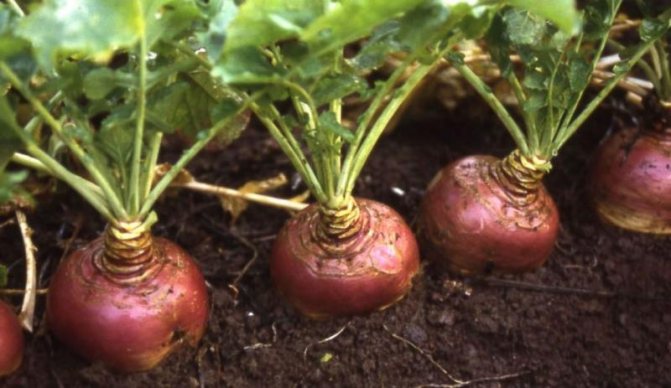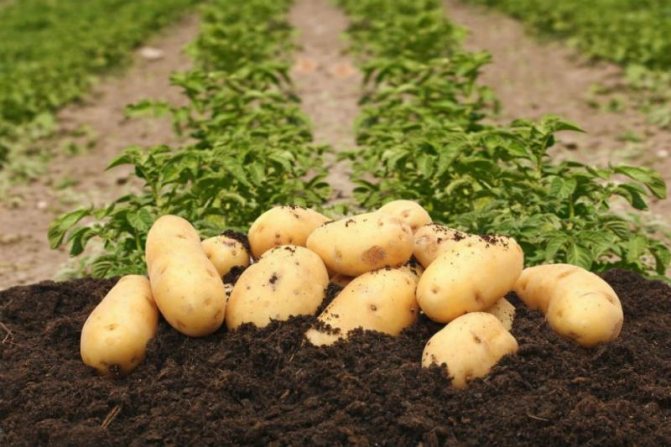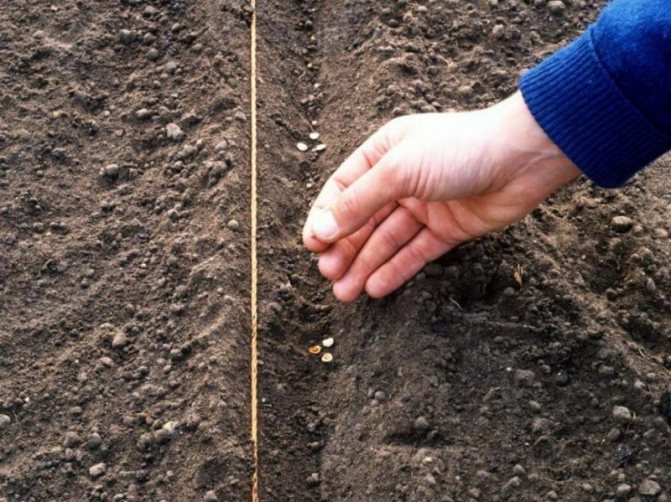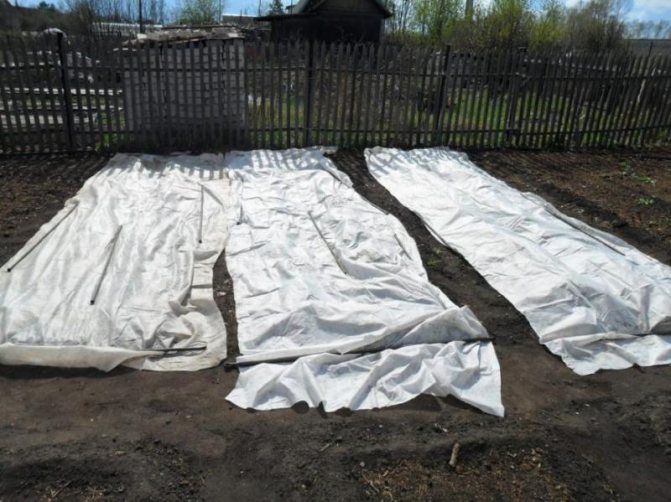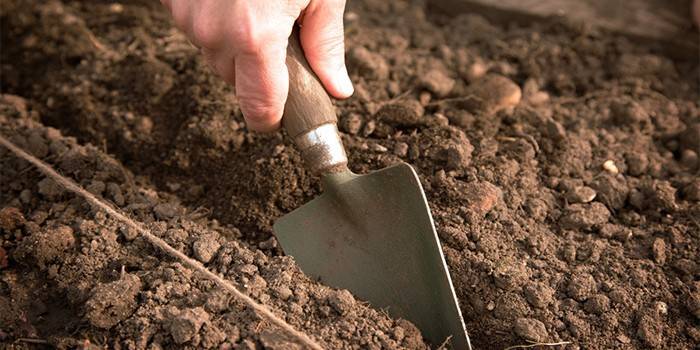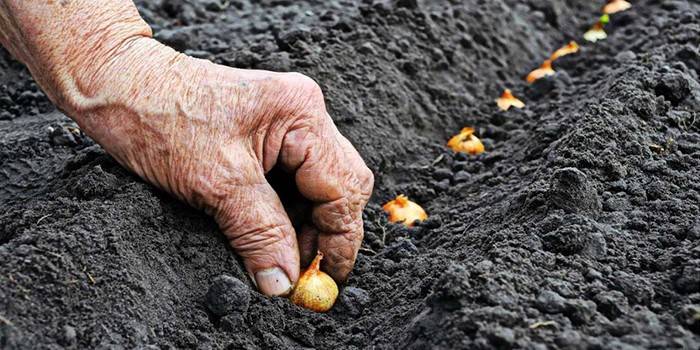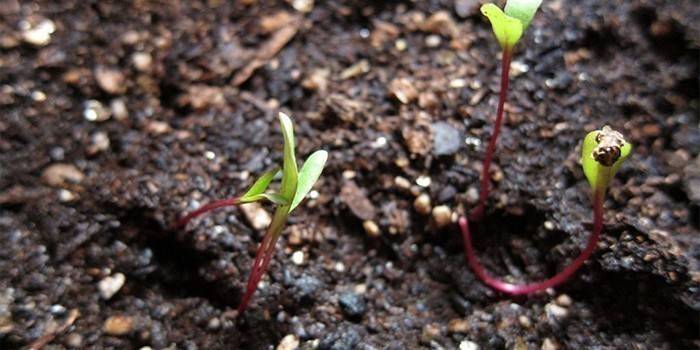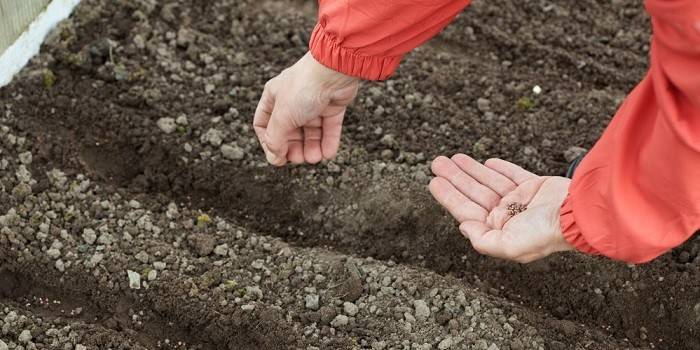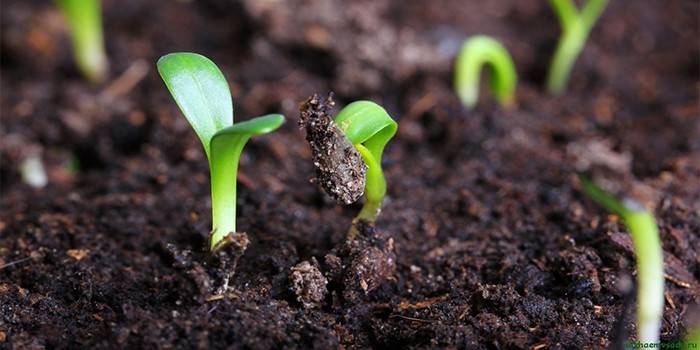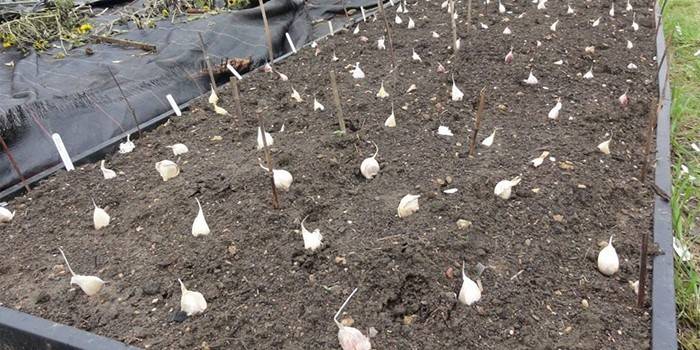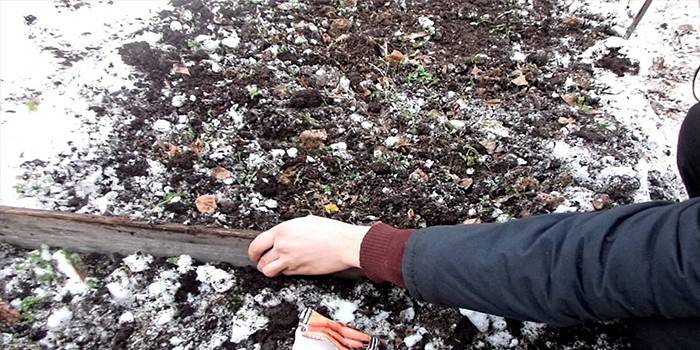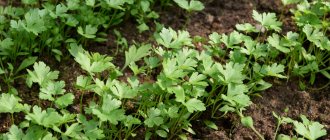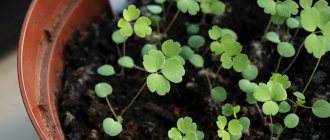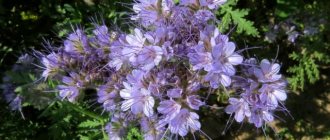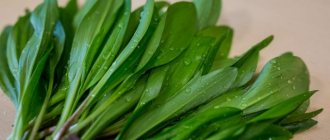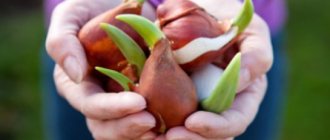Choosing crops for winter planting
So, what vegetables and flowers to choose for planting in the cold season? Their choice is wide enough:
- carrot;
- beet;
- dill;
- parsley;
- sorrel;
- garlic;
- onion;
- delphinium;
- mallow.
Select the plants that are right for you from the list above. They should be planted in fast-drying areas, flat and with fertile soil. There should be no accumulation of snow on the beds, otherwise the crops will be flooded. The height of the beds will be no more than 15 cm if the site is located in a lowland.

It is impossible to rush to sowing work, otherwise the plants may germinate before the onset of frost and die. Usually cold-resistant crops are planted in early November, while focusing on the weather - the soil temperature should drop to 3 ° C, when the risk of possible warming is minimized. The air temperature outside at this time is about 0 ° C.
Seeds, placed in the garden on the right day, wait for the onset of spring and sprout next year.
What trees can be planted in autumn
When plants shed their leaves, the root system adapts well to new conditions, so you can replant them to another place. In autumn, decorative and fruit shrubs are planted in the garden: jasmine, hawthorn, acacia or currant, raspberry, honeysuckle. Well suited for planting in the autumn and any trees. Saplings should be planted in September or early October, so that they have time to take root 25-30 days before the onset of frost.
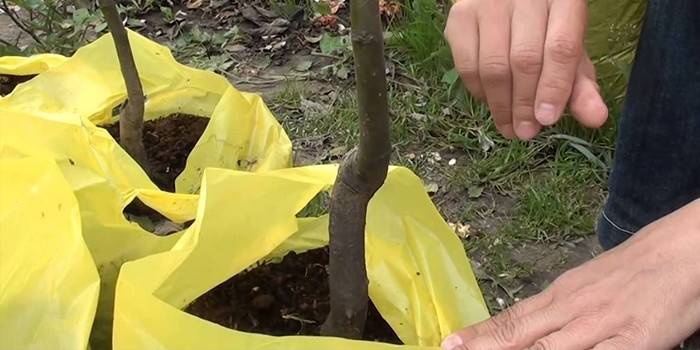

Arrangement of beds and preparation of seeds
Gardeners prepare the soil in advance, back in September.
- After harvesting, carefully dig up the ground, break up large clods with a shovel and water the beds.
- Weed residues should also be removed and fertilized. Compost, peat, humus are suitable for this purpose.
- If possible, add a natural baking powder - sawdust to the soil.
- Then make neat grooves.
- For sowing work, take dry seeds, otherwise they may germinate and die. Experienced gardeners are advised to purchase seeds placed in clay tablets for autumn planting. Such a capsule serves them as protection from the cold and rodents.
It is known that for planting before winter, you need to take a lot of seeds, since some of them may not germinate.
How to prepare the beds for winter sowing of vegetables
The preparation of the ridges plays an important role in the process of winter sowing. After all, only high-quality, reliably protected beds with nutritious soil can become worthy protection for seeds that have to endure the winter outdoors.
For sowing vegetables, it would be better to choose high beds, but if you are not a supporter of their arrangement, ordinary beds are also suitable, reliably protected around the perimeter by boards, slate, polycarbonate or other material. Such a fence will not allow the spring waters to wash away crops and retain snow on the ridges.
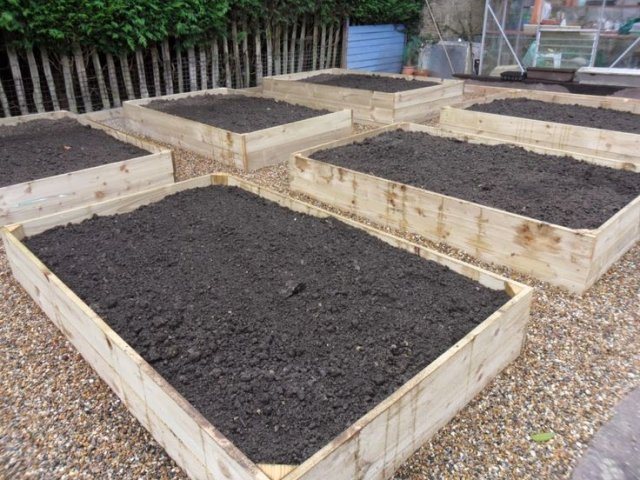

Place your plantings in the sunniest and most elevated place, where the snow melts in the spring. However, if you have such a place in an open space, take care of windproof structures, for example, install shields on the windward side.If there is already little snow in your area, do not forget to prepare in advance a layer of spruce branches or other mulch, which will replace the snow layer in your beds.
As with sowing flowers for the winter, the ridges need to be prepared in advance, while the temperature is above zero. Weed the soil, apply fertilizers with a low nitrogen content (AVA, Autumn, diammofosk, nitrophoska), draw with a plane cutter or rake angle the seed furrows 3-5 cm deep, and then cover the ridge with foil to avoid waterlogging. In separate bags, stock up the substrate for mulching plantings (garden soil with peat and sand in a 1: 2: 1 ratio), and wait for frost.


When a stable negative temperature is established, sow seeds 1.5-2 times more than the norm, cover them with prepared soil, and then mulch with spruce branches, spunbond or healthy leaf litter. The thickness of the shelter should be about 15 cm, but remember that light leaves can be blown around the area by the wind, so they need to be fixed.
There is no need to water the autumn crops - the spring melting snow will be enough to water the seeds with moisture.
Planting onions and garlic before winter
Onions have long been planted in the fall. It is unpretentious, frost-resistant, but requires loose soil and a sufficient amount of light. Arrange beds for this vegetable crop where the snow melts early and quickly in spring. But spring moisture can destroy the bulbs.
Pre-sowing processing of the material consists in a careful selection of bulbs, as well as in soaking them in a weak solution of potassium permanganate for disinfection. If the weather in your region is unstable and threatens with a sudden thaw, then it is better to plant dry onions in the ground, as it will more easily withstand temperature fluctuations.
Place the onions in holes at least 5 cm deep, the distance between the vegetables will be 7 cm.
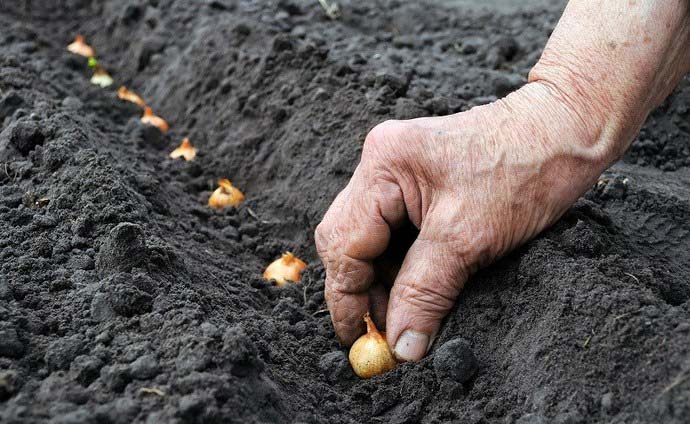

It is important to know that shallow planting is fraught with plant death, especially in a snowless winter. Just in case, the bed should be covered with the onset of frost. In the Moscow region, spruce branches, straw, dry stems of herbaceous plants are traditionally used for this. Some hobbyists also mulch the ground with sawdust or peat. In the spring, these shelters must be cleaned up in time, as soon as the soil begins to free itself from snow.
Planting garlic in the fall is as easy as planting onions. You can place the cloves where previously cucumbers, tomatoes, pumpkins, peppers or zucchini grew.
- This culture is undemanding to the composition of the soil, but the soil should be loose and not contain particles of manure. Selected dry cloves deepen into the ground by 5 or 7 cm, depending on their size. The air bulbs should be placed in the wells only 3 cm deep.
- Then the ground is sprinkled with wood ash and covered with additional materials, for example, spruce branches.
- Garlic takes root in the soil gradually, but it should not have green shoots. Planting it too late is not recommended, as the cloves can freeze into the soil.
- It is also worth remembering that any manure spoils the root system of this crop in the fall.
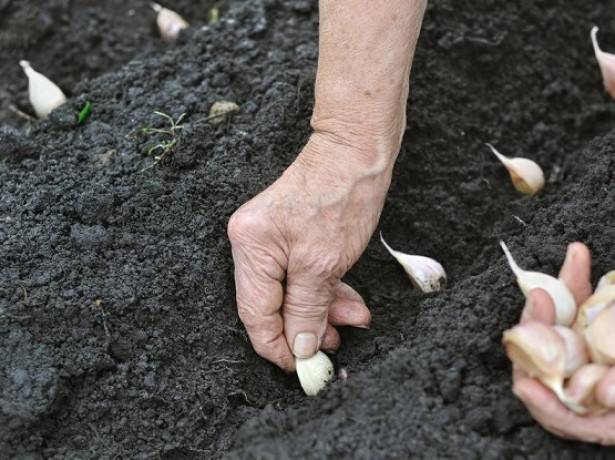

General sowing rules in late autumn
To plant seeds in the fall, you need to follow a number of rules. It:
- landing dates;
- choice of location;
- preparation of the garden;
- selection of seeds;
- shelter from the cold.
Attention!
Only the seeds of those vegetables that are cold-resistant and not prone to shooting are planted in the garden before winter.
Seat selection
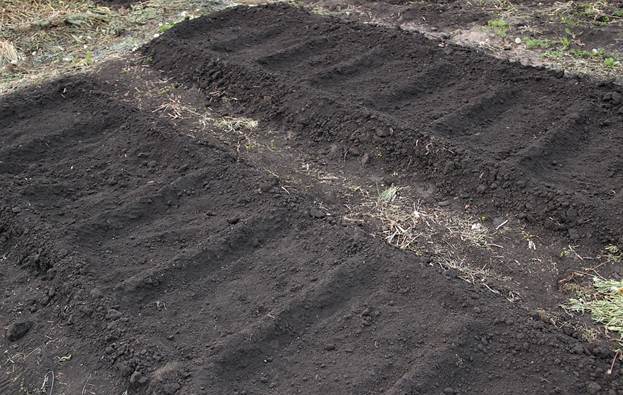

For planting vegetables before winter, choose a high bed or make it one yourself, in order to avoid spring soaking and rotting of seeds. The soil should be loose and light, clayey heavy soil over the winter is even more compacted and makes it difficult to germinate. After harvesting vegetables, 1-1.5 months before winter sowing:
- The bed is dug deeply.
- Weeds are removed.
- The necessary organic (compost and humus) and mineral fertilizers (no nitrogen) are introduced.
- Add 100-300 g of lime to reduce the acidity of the soil.
- Loosening with a rake.
If the sowing of vegetables before winter will be carried out after the first frost, grooves are made in advance and the ground is covered with a film to prevent them from erosion.
Landing dates
The main link in the chain for obtaining a good harvest is the timing of stable cold weather on the territory of residence. Warm and humid days will give the seeds an impetus to germinate, which will lead to the death of the future harvest. Failures of young gardeners associated with non-compliance with planting dates lead to an unwillingness to plant seeds of garden crops before winter. So, in the Leningrad region, before winter, planting is done much earlier (by 1.2 weeks) than spicy herbs and greens are planted before winter in the Moscow region with its more southern location and a much less harsh climate. The optimum temperature for planting will be from +3 to -2.
Seed preparation
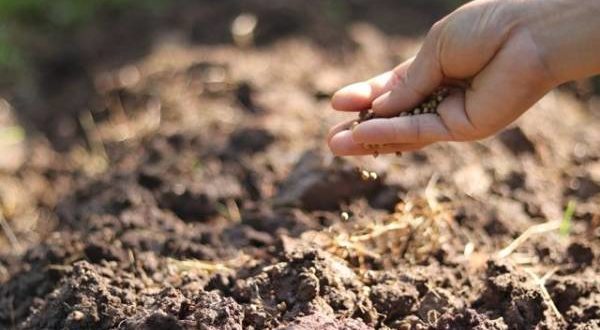

The seeds of some vegetable crops can be planted before winter, but before that it is necessary to check their quality.
Attention!
Seeds are not soaked during autumn planting. They must be dry.
Seeds suitable for planting before winter:
- resistant to flowering and shooting;
- pelleted, which will reduce their consumption during planting;
- winter hardy.
For autumn planting, the planting density should be increased by 30%.
Table with autumn sowing dates for vegetables and herbs:
| Culture name | Variety | Landing dates | Planting depth | Distance between beds |
| Onion sets | Stuttgarten, Sturon, Carmen | Mid October - early November | 4-5 cm | 20 cm |
| Nigella onion | Danilovsky, Strigunovsky, Odintsovsky | — | 1.5 cm | 20 cm |
| Garlic | Winter varieties | 1.5 months before the onset of cold weather | 4-6 cm | 15-20 cm |
| Carrot | Nantes, Losinoostrovskaya, Touchon, Samson, Shantane | At a stable temperature of + 2-3 degrees | 2-3 cm | 20 cm |
| Radish | Red giant, Soffit, Mokhovsky, Option | The beginning of November | 2-3 cm | 10-15 cm |
| Dill | Gribovsky, Umbrella | — | 2-3 cm | 15-20 cm |
| Salads | Berlin Yellow, Emerald, Large Rock | — | 1-2 cm | 20 cm |
Greens and root vegetables
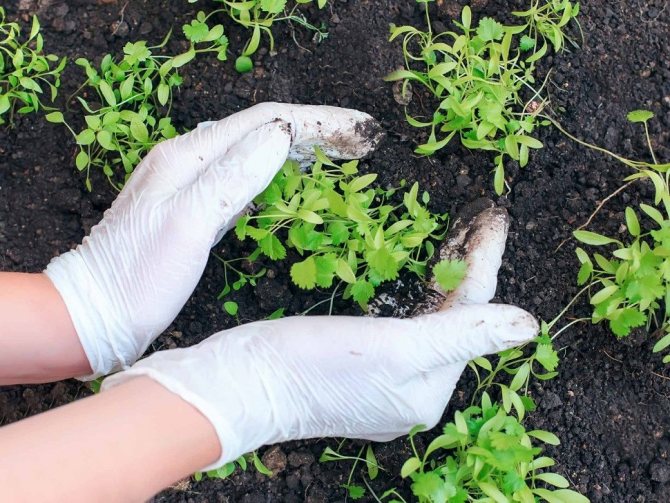

It is difficult to imagine a vegetable garden without greenery growing in it. Every amateur gardener wants to grow vitamins for the table as early as possible. To get spring vitamins right after the snow melts, you can plant greens in autumn. In this case, the seeds:
- are quenched;
- the plant does not get sick.
In the middle lane, they are planted in the fall in the garden:
- dill;
- cilantro;
- parsley;
- sorrel;
- salad.
When planting lettuce before winter, you need to choose leafy varieties, half-cabbage ones may not give the expected harvest.
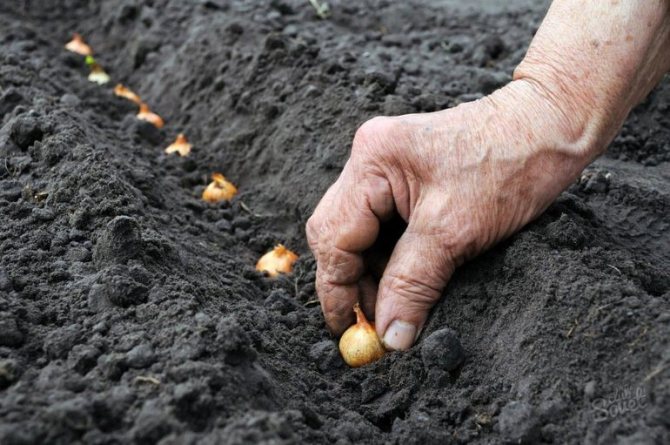

You may be interested in:
Planting onions in the open ground before winter There are over 900 varieties of onions. This culture is popular with most gardeners due to its ... Read more ...
Vegetable crops that can be planted in the fall include:
- cabbage;
- carrot;
- beet;
- radish.
To sow cabbage before winter, choose medium-ripe or late varieties, the early one is not suitable for such planting. Among the advantages of autumn planting, it is worth noting:
- harvesting 2.3 weeks earlier than when planting in spring;
- getting moisture by seeds from the spring melting of snow and sprout quickly;
- freeing up spring time for growing seedlings of other crops;
- improved taste and juiciness;
- resistance to diseases and less losses from pests.
Of the minuses, it can be noted:
- greater consumption of seeds;
- preparing beds for planting at the end of summer;
- the need to shelter seedlings from frost in early spring;
- the need to accurately determine the timing of landing.
To plant beets in the fall, varieties are selected that are intended for autumn sowing and are resistant to shooting. Only a sunny place is suitable for beets; in the shade, it forms tough, small roots with less sugar.The bed is prepared for sowing in advance, grooves are made at a distance of 30 cm from each other and a depth of about 5 cm. They are waiting for the temperature to settle from - 2 to +5 degrees. Beets are sown more frequently than during spring planting. Furrows are covered with pre-prepared soil, mulch in the form of peat, humus, compost is added on top and covered with branches of coniferous trees.
You can also plant beet and carrot seeds before winter. Early and cold-resistant varieties are suitable for planting. The preparation of the planting site is done in the same way as for beet beds.
Planting garden strawberries


Also planted in the winter in the garden and garden strawberries. You should not linger with these works, since young bushes should take root and leave strong and healthy before winter. They are engaged in transplanting in late August - early September. The strawberry bed is prepared 2 weeks before planting, so that the soil has time to settle. When digging, add compost or humus, ash, mineral potash-phosphorus fertilizers. The distance between the rows during planting is about 50-70 cm, depending on the variety, between the bushes in a row there should be at least 30-40 cm.
Autumn planting of flowers
You can sow not only vegetables, but also flowers before winter. Preparing the land follows the same principle as for vegetables. The difference is in the seeding depth, which depends on the seed size.
| Seed size | Sowing depth, cm |
| small | 0,5-1 |
| average | 2 |
| large | 4-5 |
Such flowers are sown before winter (annual):
- lavaters;
- cornflower;
- calendula;
- poppy;
- matthiola;
- mignonette and many other colors.
From perennials, seeds of Gaillardia, bellflower, swimsuit, primrose and other flowers are suitable for autumn planting.
Sowing fragrant greens
Fresh greens are good for the body, and those grown in early spring are especially rich in vitamins and are pleasing to the eye in an empty area. Shortly before the first frost, gardeners sow parsley and dill.
- Loosen the soil well, level it with a rake and make grooves up to 2.5 cm deep. Sow dry seeds in them in large quantities, then cover them with fertile soil.
- Choose a bright place for the garden, avoid the accumulation of snow and spring waters. If you follow these simple rules, you will feast on fresh herbs with the onset of the May holidays.
When are the crops harvested during winter sowing?
Seeds sown before winter begin to germinate immediately after the topsoil has warmed up to the required temperature. As a result, the crop can be harvested 2-3 weeks earlier than from the beds sown in spring. This is especially true for tugovidny carrots and dill, the seeds of which require good moisture.


To speed up the formation of the crop, for example, green, the garden bed, without waiting for the snow to melt, is covered with non-woven material. You can also stick arcs in the fall, and stretch a greenhouse film in early spring. Such temporary shelters will accelerate soil warming and seed germination, as well as protect young seedlings from spring frosts.
Some crops with a long growing season and low germination energy have time to ripen only with podzimny sowing. In northern regions with short summers, winter crops in an unheated greenhouse are promising. This will allow you to get early greens and roots on the bunch.
Planting perennials in the cold season
Perennial flowers can be planted not only in spring but also in autumn. Then your site will become colorful much earlier than the neighbor's. In addition, plants hardened by low temperatures are resistant to garden diseases and grow stronger.
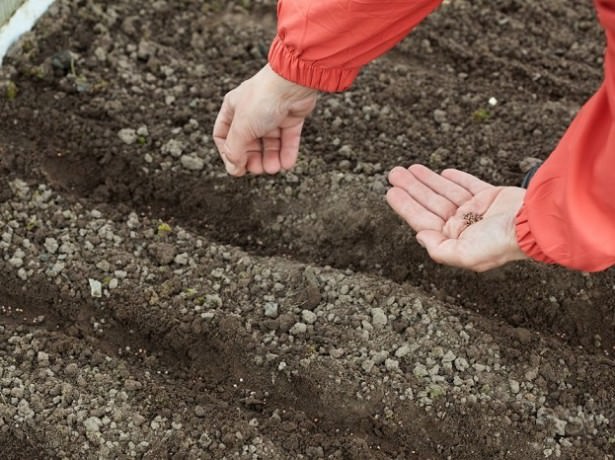

In early November, you can plant mallow seeds. This flower is undemanding, amazes gardeners with a variety of shapes and shades of inflorescences. It grows in suburban areas, gardens and city parks.
- Fertile and loose soil is prepared in advance, before the onset of cold weather. The depth of the holes for small seeds is 1 cm, after planting they are covered with earth and insulated with dry leaves.
- In the spring, when the snow melts, the seedlings are protected from hail and wind by setting up a kind of transparent film greenhouse above them.
- Soon they will strengthen and turn into tall beautiful flowers that will delight you for a long time with their spectacular appearance. Growing them on the site is an interesting and not troublesome process.
Delphinium is another perennial plant that is often grown by gardeners. Flowers can be blue, light blue, purple, white. They do well in sunny places and prefer moderately moist, loamy soils.
- Sowing delphinium is allowed before winter. The seeds tolerate a decrease in temperature well, in addition, they need cold for better germination.
- Some gardeners start sowing as early as October. Seeds are planted in the previously prepared loose soil to a depth of 2 cm. Then the bed is covered with earth, leveled and hidden with mulching material or spruce branches. In the spring, when it gets warm, perennials germinate and also need a film cover from the rain.
- Sometimes delphinium seeds are placed in the refrigerator by gardeners for a long time, and in the spring they are sown in the ground. With the same success, they can overwinter directly in the soil.


Trees and shrubs
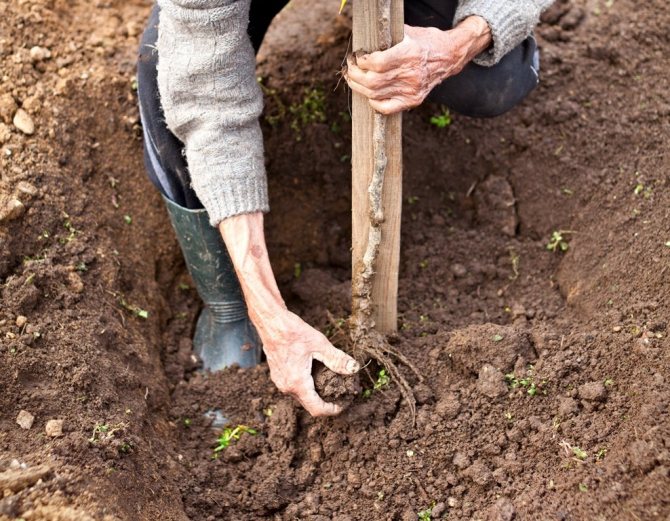

In the garden in autumn they sometimes plant:
- apple trees;
- pears;
- plums;
- cherries and other fruit trees.
Benefits of autumn planting:
- the tree wakes up in the spring in a new place;
- undisturbed roots grow rapidly;
- a seedling, planted 2-3 weeks before the onset of stable cold weather, manages to take root and grows quickly in spring.
Therefore, in the middle lane and in the Moscow region, trees are planted in October, and in the northern regions in mid-September.
The disadvantages include the possible freezing of a young tree. This happens for several reasons:
- landing too early;
- the wrong variety was chosen (a fruit tree seedling, bred for planting in the southern regions, was planted in the northern regions);
- manure or mineral fertilizer with nitrogen content was added to the hole during planting, which will give an impetus to the growth of the seedling and lead it to death in the winter;
- deepening of the root collar;
- a young tree has dried roots if it was transported with an open root system.
The chances of survival are higher for a seedling with a closed root system.
Attention!
Planting should be done while the plant is dormant.
Shrubs that can be planted before winter:
- red and black currants;
- gooseberry;
- honeysuckle.
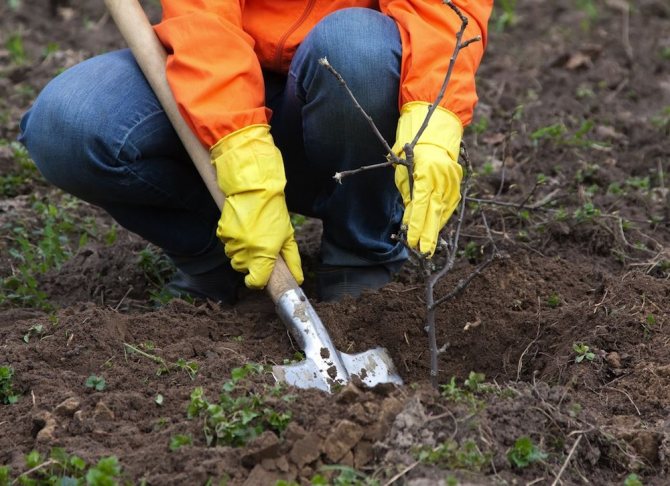

The correct approach to the autumn planting of shrubs will lead to a high survival rate of the planting material and to productivity. The benefits of landing at this time include:
- the opportunity to buy goods from nurseries at lower prices than in the spring;
- the ability to inspect the whole plant, including the roots, if the root system is open;
- release of spring time for other work;
- the likelihood of successful survival to cold weather and take down new roots;
- planting an apple tree in spring (or other trees) will result in little or no yield in the first year.
Among the minuses are noted:
- damage to young bushes by rodents;
- damage to young branches by winds and adhered snow;
- a sharp cold snap after heat can destroy a plant that has not had time to take root.
Before planting, a seedling purchased with an open root system is placed in a bucket of water with the addition of Kornevin to allow it to absorb moisture. To plant a bush in the ground, first dig a hole about 30-40 cm deep and 50-60 cm wide. Ash, a handful of superphosphate, humus or compost are added there, everything is mixed. A seedling is placed, the roots are carefully straightened, covered with earth, tamped a little so that there are no voids around the roots.Then the plant is shed by pouring at least 15 liters of water under it. From above they mulch with peat, dust from sawdust, compost. You should not take straw or hay as mulch, they will attract rodents.
Benefits of autumn planting
Planting before winter is a risky business. If everything is done correctly, then the harvest can be obtained 2 weeks earlier than usual. How not to be delighted with fresh greens in early May? In addition, seeds that have been in the soil all winter have passed natural selection and stand out for their health and resistance to diseases. They grow strong plants that give an excellent harvest.
Vegetables and flowers develop a powerful root system that extracts water and nutrients in the deep layers of the earth. By harvesting early vegetables and herbs, you can plant many crops again.
Why I decided to grow greens in the garden
Every gardener has a favorite greens - edible leaves, stems of young plants. I grow it for a number of reasons:
- Vitamin supplement, delicious natural seasoning for many dishes.
- Possibility of consumption not only fresh, but also long-term drying, canning, freezing.
- Ease of sowing, care.
- Unpretentious crops that are not afraid of heat and frost, drought and rainy summer.
- High yield from early spring to late autumn.
It is incorrect to say that it is enough to sow greens and they will grow violently throughout the season. To harvest a rich crop, you need to provide the plant with care. For unpretentious greenery, it is not difficult, but a must.
How to properly grow greens in the garden
Most varieties of greenery are unpretentious, so the plants are planted in mixed beds, any free areas.
Site selection
The place can be somewhat shaded or well lit. The more it is heated by sunlight, the sooner the "natural spice" develops, the juicier and tastier the leaves. Greenery loves somewhat elevated areas - they rot on boggy roots. Therefore, in lowlands, ravines, ridges with greenery are artificially raised.
Good predecessors:
- pumpkin;
- squash;
- legumes;
- zucchini;
- siderates;
- cucumbers;
- beet;
- pepper;
- potatoes;
- eggplant.
Do not plant it on the site of last year's spice bed. Cabbage, turnips, carrots will not be the best predecessor.
Soil preparation
Greens take root well on a substrate prepared in the fall. It is enough to introduce humus, mineral compositions. If the land is poor, in the spring it is additionally enriched with ammonium nitrate, urea, potash, phosphorus compounds.
I apply the following fertilizers for greens:
- Organic. 1 bucket of compost, humus per 1 m2.
- Mineral compositions (per 1 m2): superphosphate - 10-12 g, ammonium nitrate - 15-20 g, potassium sulfate - 8-10 g
Before planting greenery, the site is dug up, weeds and the remains of last year's plants are removed. Then it is carefully loosened, leveled with a rake.
Landing scheme
For the full development of green mass, openness to sunlight, the absence of competition for food is required. Therefore, for beds with greenery, frequent sowing is contraindicated: between individual plantings they maintain 7-15 cm. Between lines, furrows - 10-20 cm. Approximately at this distance, greens are sown from neighbors in a mixed bed.
In order for the harmonious coexistence of the "green" to continue, every 2 weeks the ridges with greenery are thinned out: weak, sick, old specimens are removed.
What is next door
Greens are versatile crops that are suitable for mixed ridges, sowing row spacings. Most greens have a straight, long root. This allows you to absorb nutrients from the deep layers of the soil without creating competition with other crops. Coexistence with greens is good for its neighbors: the tart aroma of herbs scares away spider mites and aphids.
The most harmonious neighborhood:
- parsley - tomatoes, strawberries;
- basil - peppers, eggplants, tomatoes;
- salad - onions, radishes, eggplants, cabbage;
- spinach - potatoes, strawberries, beans, tomatoes, beets, carrots;
- dill - cucumbers, pumpkin seeds.


growing basil in the garden
Greens are planted not only in open ground - they feel good in greenhouses and greenhouses.
What varieties of parsley are suitable for autumn sowing?
It is known that parsley is root, large cone-shaped roots of which are used for the preparation of medicinal broths, for canning, in the preparation of liquid dishes, sauces, and leafy, to obtain aromatic lush greenery.
Parsley varieties are chosen depending on the needs:
- an old favorite variety, early ripening, pointed conical roots, reaching a length of 30 cm in loose soil, high leaf rosette, excellent taste of roots and leaves;

root sugar- root Russian size - the underground part can grow more than 30 cm in length, juicy snow-white pulp with a pleasant aroma and sweetish taste;
- root Eagle - unpretentious in cultivation, leveled root crops have a pronounced aroma, leaf rosette has lush greenery;
- leaf Ordinary - cold-resistant, when planted in the fall in open ground, it winters well, gives early, lush and fragrant greens;
- leafy Italian giant - mid-season, with dark green carved large leaves, after cutting it quickly grows a young green mass;
- leafy curly Esmeralda - decorative corrugated leaves are suitable for eating and decorating cooked dishes.
It is better when planted varieties that are best adapted to local conditions are planted.


